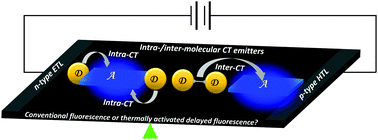Engineering the excited-state properties of purely organic intramolecular and intermolecular charge transfer emitters towards high-performance fluorescent OLEDs†
Abstract
A direct comparative investigation on the electrofluorescence performances of pure-organic intramolecular charge transfer (ICT) and intermolecular charge transfer (inter-CT) materials, which have high correlation in their molecular structures, was carried out. An n-type spiro-sulfone-based acceptor (DSO2) with a sufficiently large molecular weight is developed to serve as the acceptor in both ICT and inter-CT systems. Through manipulating their excited-state properties by molecular engineering, transformation of conventional fluorescence and thermally activated delayed fluorescence (TADF) from both the inter-CT and ICT systems could be rationally modulated. Accordingly, a conventional fluorescent, non-doped, blue OLED with an external quantum efficiency (EQE) >6.0% at a luminance of 1000 cd m−2 and a low turn-on voltage (Von) of 2.76 V was obtained; maximum EQEs of 18.2% and 25.4% were achieved for the non-doped and doped sky-blue OLEDs employing an ICT emitter with a TADF character, respectively. Besides, an OLED using the inter-CT emitter could also show good device performance with an EQE of up to 10.2%. This study contributes to understanding how to develop high-performance ICT and inter-CT emitters with selective thermally activated delayed and conventional electrofluorescence through excited-state modulation.



 Please wait while we load your content...
Please wait while we load your content...